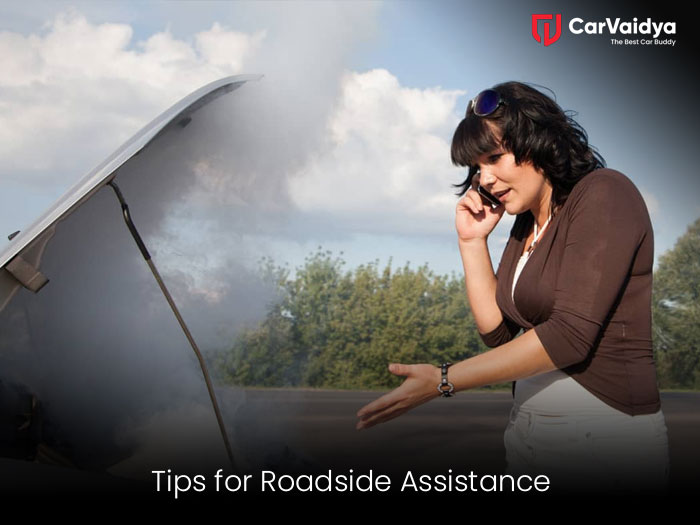Tips for Roadside Assistance in the Summer


 By CarVaidya
By CarVaidyaSummer is a time of travel and adventure, but it can also bring unique challenges for drivers. The heat can take a toll on your vehicle, and being stranded on the side of the road in sweltering temperatures is no one's idea of a good time. Here are four essential tips for ensuring you are well-prepared for roadside assistance during the summer months.
An emergency kit is a must-have for any vehicle, especially during the summer. Here's what you should include:
Water: Dehydration can set in quickly, especially if you're waiting for help in the heat. Keep a few bottles of water in your car at all times.
Non-Perishable Snacks: Energy bars, nuts, and dried fruits can keep your energy up while you wait for assistance.
First Aid Kit: Make sure it includes bandages, antiseptic wipes, pain relievers, and any personal medications.
Flashlight and Extra Batteries: Even though it's summer, you might find yourself needing light if your breakdown happens at dusk or dawn.
Basic Tools: Items like a multi-tool, duct tape, and a tire pressure gauge can be incredibly handy.
Reflective Triangle and Flares: These can alert other drivers to your presence and keep you safe.
Portable Phone Charger: A dead phone battery can turn an inconvenience into an emergency if you can't call for help.
By keeping these items in your car, you’ll be better equipped to handle the unexpected and stay safe while waiting for assistance.
Preventative maintenance can go a long way in avoiding breakdowns. Here are some key areas to focus on, particularly in the summer:
Cooling System: Check your coolant levels regularly and ensure your radiator and hoses are in good condition. Overheating is a common cause of summer breakdowns.
Tires: Heat can cause tires to expand and potentially blow out. Check the tire pressure often and inspect for any signs of wear or damage.
Battery: High temperatures can strain your battery. Ensure it's securely mounted and check for any corrosion on the terminals.
Air Conditioning: Not only is a functioning AC system important for comfort, but it can also prevent heat exhaustion if you find yourself stranded.
Brakes: Ensure your brake fluid is at the proper level and that your brake pads are in good condition. Heat can cause brake fluid to thin, reducing braking efficiency.
Oil: Summer driving often means longer trips and heavier loads. Regularly check your oil level and quality, and change it as recommended by your vehicle's manufacturer.
By staying on top of these maintenance tasks, you can reduce the risk of a breakdown and ensure your car is ready for summer travel.
It's crucial to be aware of your roadside assistance options before you need them. Here's what you should consider:
Insurance Coverage: Many auto insurance policies offer roadside assistance as an add-on. Review your policy to understand what services are included and under what conditions.
Automobile Clubs: Organizations like AAA provide comprehensive roadside assistance plans that include towing, battery service, tire changes, and more.
Manufacturer Assistance: If your car is still under warranty, it might include roadside assistance. Check with your dealership for details.
Apps and Services: There are numerous apps like Honk, Urgently, and Blink that connect you with local roadside assistance providers. These can be a quick and convenient option.
Make sure to have the contact information for your chosen service easily accessible, either saved in your phone or written down in your emergency kit. Knowing who to call can significantly reduce stress and response time when you're stuck on the side of the road.
If you do find yourself stranded, safety should be your top priority. Follow these steps to ensure you and your passengers stay safe:
Move Off the Road: If possible, get your vehicle off the road and onto the shoulder or into a parking lot. This reduces the risk of being hit by passing traffic.
Stay Inside the Vehicle: If you're on a busy road or freeway, it's usually safer to stay inside your vehicle with your seatbelt fastened. If you must exit the vehicle, do so with extreme caution and move away from traffic.
Signal for Help: Use your hazard lights, reflective triangles, or flares to signal to other drivers that your vehicle is disabled.
Stay Visible: Wear brightly colored or reflective clothing if you need to step out of your vehicle, especially at night or in low-visibility conditions.
Keep Doors Locked: If you're waiting for professional assistance, keep your doors locked and only open them for identifiable personnel.
Monitor the Situation: Stay aware of your surroundings and keep an eye on the status of your vehicle. If it starts to overheat or if you're running out of fuel, be prepared to relay this information to the assistance provider.
By following these safety tips, you can protect yourself and your passengers while waiting for help to arrive.
Summer driving can be a joyful experience, but it requires careful preparation to ensure safety and reliability on the road. By preparing an emergency kit, maintaining your vehicle, knowing your roadside assistance options, and staying safe while waiting for help, you can handle roadside emergencies effectively. These proactive measures can turn a potential disaster into a manageable inconvenience, allowing you to enjoy your summer travels with peace of mind.
Essential Car Steering Tips Common Mistakes to Avoid While Driving
Tips for Choosing the Right Car Loan What To Consider
Understanding and Addressing Issues With Spark Plugs In Cars


0 Comments